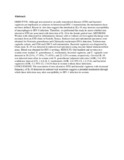| dc.description.abstract | OBJECTIVE:
Although non-ulcerative sexually transmitted diseases (STD) and bacterial vaginosis are implicated as cofactors in heterosexual HIV-1 transmission, the mechanisms have not been defined. Recent in vitro data suggest that interleukin (IL)-10 may increase susceptibility of macrophages to HIV-1 infection. Therefore, we performed this study to assess whether non-ulcerative STD are associated with detection of IL-10 in the female genital tract.
METHODS:
Women with clinical pelvic inflammatory disease with or without cervicovaginal discharge were recruited from an STD clinic in Nairobi, Kenya. Endocervical and endometrial specimens were obtained for Neisseria gonorrhoeae and Chlamydia trachomatis DNA detection, Trichonomas vaginalis culture, and CD4 and CD8 T-cell enumeration. Bacterial vaginosis was diagnosed by Gram stain. IL-10 was detected in endocervical specimens using enzyme-linked immunosorbent assay. Blood was obtained for HIV-1 serology.
RESULTS:
One hundred and seventy-two women were studied. N. gonorrhoeae, C. trachomatis, bacterial vaginosis, and T. vaginalis were detected in 38 (21%), 17 (9%), 71 (43%), and 22 (12%) women, respectively. Cervical IL-10 was detected more often in women with N. gonorrhoeae [adjusted odds ratio (AOR), 3.4; 95% confidence interval (CI), 1.4-8.4], C. trachomatis (AOR, 4.4; 95% CI, 1.2-15.6), and bacterial vaginosis (AOR, 3.1; 95% CI, 1.4-6.9) than in women without these infections.
CONCLUSIONS:
The association of non-ulcerative STD and bacterial vaginosis with increased frequency of IL-10 detection in endocervical secretions suggests a potential mechanism through which these infections may alter susceptibility to HIV-1 infection in women. | en |


